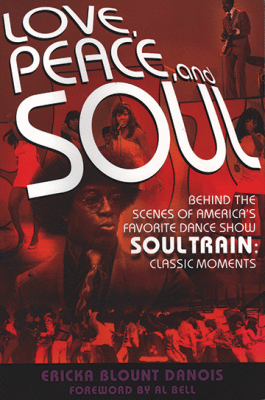An inside look at Soul Train and the man who drove it.
[column col=”1/4″]
LOVE, PEACE, AND SOUL: Behind the Scenes of America’s Favorite Dance Show
By Ericka Blount Danois C’94
Backbeat Books, 2013, $24.99.
[/column]
By Tim Whitaker | American Bandstand showed up in our living rooms nearly two decades before Soul Train rounded its first turn on the television rails in 1971.
On paper, Soul Train looked like little more than a Bandstand clone. The prototype was strikingly similar. Soul Train would be a TV dance show built around a high-profile host. It would showcase the latest musical acts and feature kids dancing to recorded music. The four-word elevator pitch: Bandstand for black people.
But the differences between Bandstand and Soul Train would turn out to be seismic. Bandstand was rock-and-roll for the suburban mall set. The music was a Top 40 potpourri, and the dancers on the show—particularly after Bandstand moved from Philadelphia to California in 1964—did little more than sashay around the studio.
Soul Train , by contrast,was a straight shot of funk-and-soul adrenaline, a nonstop party machine, where the host and guests dressed to impress and the dancers, particularly during the show’s renowned dance line segment, executed moves with a combination of street bravura and acrobatic acumen. As a Soul Train fan club president would later put it, “People on Bandstand were dancing to the music; people on Soul Train were dancing in the music.”
For white kids, Soul Train was mysterious and exotic, a world way cooler than their own. Black kids would find it a revelation, a reflection of their own lives and dreams—a miracle, really, that undiluted black youth culture was being celebrated on TV. How could this be?
Soul Train was black radio brought to television. On black radio, it was the cool, good-looking jocks, like Frankie Crocker in New York and Jimmy Bishop in Philadelphia, who became the stars. Why mess with a winning formula?
Don Cornelius, Soul Train’s founder, a 6-foot-5-inch Chicago-bred, baritone-voiced, former radio journalist with an Afrocentric mindset and hairstyle, enviable entrepreneurial drive, and a bottomless personal reservoir of style and cool, took on the role of the show’s TV jock.
Like the black radio jocks, Cornelius cooked up signature lines to use on the show. His most famous was a promise: “You can bet your last money it’s all gonna be a stone gas, honey!”
Soul Train was on television, in syndication, for 37 years. That’s a lot of track for an author to traverse, particularly since the show broke racial barriers, debuted innumerable artists of color, and created rock stars out of city neighborhood kids. Inside Soul Train, there were stories within stories within stories.
Author Ericka Blount Danois made a smart decision by focusing her narrative tightly on the life of Cornelius. The other players in the Soul Train story have their share of moments—there are juicy tidbits about the dancers (Marvin Gaye had a tryst with one!) and the performers (James Brown and Joe Tex get into a major tussle!)—but all that is mere noise compared to the man in charge.
Focusing on Cornelius was a wise decision not just for structural purposes but because he was at once compelling and enigmatic—a scenester, entrepreneur, hipster, activist, control freak, and, underneath it all, a troubled soul.
That last characteristic would come to dominate his biography when, in 2012, Los Angeles police officers responded to a report of a shooting on Mulholland Drive. There they found Cornelius’s lifeless body in an armchair, “still clutching a 9 mm Smith and Wesson.” He was 75, and very alone at the time he shot himself through his right temple.
Cornelius’ shocking suicide, referenced early in Love, Peace, and Soul, is much of what keeps pulling readers through the book’s narrative. Who wouldn’t want to know the why behind such a despairing final act?
But fairness dictates that we first know why Don Cornelius should matter. Love, Peace, and Soul does right by him in that regard.
Cornelius got Soul Train on the air by promising excellence and convincing George E. Johnson, owner of Johnson Products, one of the largest black-owned manufacturers of hair and facial cosmetics in the world (Afro Sheen!), to become the show’s major investor and advertiser. It was the first time a black advertiser sponsored a nationally syndicated show.
By 1975 Johnson Products—“in large part generated from Soul Train advertising”—had become a $35 million business. When James Brown came to appear on the show, he asked Cornelius, “Who’s behind you on this?” The implication: no way a brother could pull off a show so sophisticated without a white benefactor.
Cornelius made sure blacks worked behind the scenes, too. Jody Watley, a dancer who went on to have a singing career, said: “I remember looking at the cameramen, the women on staff. He employed people of color. Going on other shows, you saw how different it was.”
When called on to talk about the lack of diversity in television, Cornelius was unafraid. “The minute number of blacks—and other minorities—represented as writers, directors, and producers is appalling,” he told Variety. He would slip political messages into Soul Train via drop-in guests, like LA Mayor Tom Bradley and a young Al Sharpton. He famously allowed singer Curtis Mayfield to talk about his distaste for the depiction of blacks in Superfly, a movie Mayfield himself had scored.
Soul Train was the heady TV party no one wanted to see end, and for a long time it seemed it never would.
But times and music change, and when rap hijacked soul and R&B and became the genre of the moment, the unthinkable happened: Don Cornelius lost his cool.
Like many of his generation, Cornelius didn’t understand rap. He fumbled interviews with Run-D.M.C. and Public Enemy. When the Beastie Boys appeared on Soul Train, they began “slam dancing into the audience of Soul Train dancers.” Cornelius looked on, clearly lost, not knowing whether to reject the new music as an irritation or embrace it as the new wave.
In a particularly cruel blow, the Wayans brothers created a spoof called Old Train that aired on their comedy show In Living Color. In the skit, Cornelius can’t remember the names of the artists—or much of anything. At the BET Awards not long after, Danois reports, Cornelius’s first public appearance in years mirrored the In Living Color spoof. His entrance was “muddied by the sympathetic looks of older audience members and the silent snickers of younger patrons, saying with their eyes, ‘It’s time to hang it up, old man!’”
Don Cornelius was a lot of things, not all of them pretty. Love, Peace, and Soul could have explored the unbecoming aspects of Cornelius’s life in a bit more detail. We see only flashes of the arrogance and bullying. We learn, in passing glimpses only, of his affection for booze, blow, and blondes (though his tastes were catholic enough to include redheads and brunettes).
So it comes as a bit of a stunner when Cornelius is arrested in 2008, just as the show is shutting down, on a felony domestic-violence charge against his wife—“the much younger, green-eyed, red-haired Russian model, Viktoria Chapman-Cornelius.” A bitter divorce follows, Danois writes, “putting a dent in [Cornelius’s] multi-million-dollar enterprise.”
Danois makes the case that in the end it wasn’t personal demons but health issues—repeated seizures from earlier brain surgery, constant pain, incontinence, blurry vision—that threw Cornelius into the ultimate desperate state. Could be. As Danois writes, “Maybe [Cornelius] worked too hard and loved too little. Or maybe it was the other way around. It’s always hard to tell about anyone’s life.”
Whatever the case, credit the man for keeping his promise. Soul Train was indeed a stone gas, honey.
Tim Whitaker, a longtime writer and editor, is the executive director of Mighty Writers, a nonprofit that teaches kids how to write.




